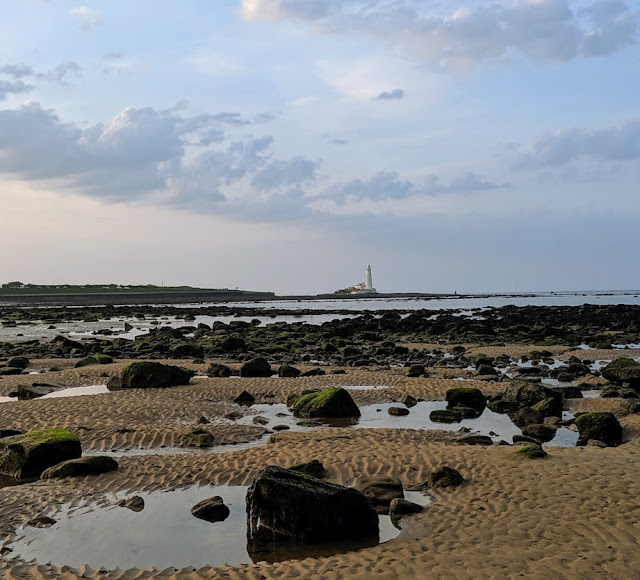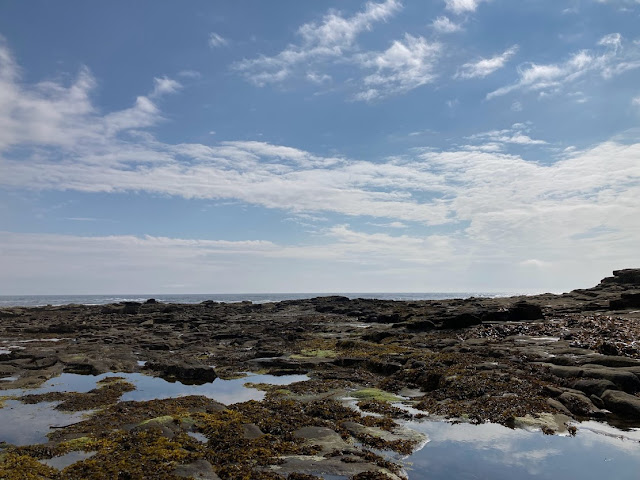 |
| St Abbs |
- It's FREE / super low cost
- Kids and grown ups love it
- No booking required
- Accessible by public transport
- Educational activity
How to go Rock Pooling & Crabbing in the North East
When you’re looking for a cheap day out you can’t jumping in the car packed with fishing nets, bucket, towels and a picnic and heading for the seaside for one of our favourite things to do – rock pooling!
There are plenty of beaches in the North East to go rock pooling and there are even some organisations offering a ‘Rock Pool School’ although we find doing it ourselves to be just as much fun (and free!)
If you are looking for something more organised, check out A Seashore Safari with Ranger Jane here.
Where to go rock pooling in North East England 
Craster
Some of our favourite beaches for rock pooling are:
- Cresswell Beach
- Tynemouth Longsands
- South Shields Beach
- St Mary's Island
- Whitley Bay Beach (Briardene area)
- Craster
- Amble
- Colywell Bay
- Newbiggin Beach (fab for crabs in rockpools)
- Marsden Beach
Check out our guide to the best beaches in the North East.
What’s the best time to go rock pooling
You’ll find the most sealife at low tide. You can find out when the best tides are online. Our favourite website for this is tides4fishing (this shows the tide times and charts for Amble, England and weather forecast for fishing in Amble in 2022).
 |
| Whitley Bay |
Click on the nearest location to you and then click on “Tide Table”. You want to aim for as close to low tide as possible. Tides lower than 1.2m are great!!
How to go rock pooling
According to BBC Countryfile the most humane way to go rock pooling is to slowly lower a bucket into the water and check what's inside when you pull it back up again.
Once you've had a good look at the creatures you find, slowly push the bucket back into the water, returning the creatures to their home.
“Nets aren't recommended when rock pooling as most of the creatures are small and getting stuck in the net which can seriously harm them.”
Get stuck in - pick up rocks to see if there's a crab underneath and inspect seaweed to try and find what creatures are living within it.
Make sure you investigate crevices in the rocks to find shellfish, but always return them once you've observed them.
What can you find?
Wildlife including crabs (we’ve found lots of hermit crabs), snails, shrimps, limpets anemones and starfish can all commonly be seen in rockpools around the coast.
 |
| St Mary's Island |
Keep a list or tally of how many you find or take pictures and draw the creatures you find afterwards for an extra activity thrown in!
You can buy books to help you identify any creatures you may spot too.
What equipment do you need to go rock pooling?
- All you really need is a bucket (ideally a transparent one so you can closely observe the creatures you find!)
- Grippy waterproof shoes are also handy on the slippery rocks
- Swimming costumes and towels for a dip in the sea afterwards if you’re feeling brave
- If it’s a sunny day remember the hats and suncream!
Crabbing
Once you’ve mastered rock pooling or if your kids are a bit older you can level up to crabbing. Great places to do this are harbour walls and piers. You’ll see plenty of people sitting next to the edge with a bucket full of crabs and a line hanging down into the water.
- Seahouses
- Cambois
- Howick Scar
- Beadnell
- Berwick
- Holy Island
- St Mary's Island
- South Harbour Blyth (along the pier near the rocks)
- Whitby is also great
Crabbing essentials
- Buckets and lines - We picked up crab buckets and lines from Poundland for £1 each recently, so worth checking there or other discount shops as they will be much cheaper than buying them from a seaside shop.
- Bait - The best bait for crabs is bacon, which you can buy cheaply already chopped up
- Sanitiser (tip - bring some hand sanitiser or wipes to clean your hands after putting it on the line!)
How to go crabbing
- Fill your bucket with seawater and then attach the bacon - either in a special net bag or tied on to your line. Don’t use a line with a hook as this will damage the crabs.
- Simply lower the line into the sea and wait!
- When the crab nibbles you’ll feel a tug on the line and it’ll feel heavier.
- Slowly bring the line up and the crabs(s) will be clinging to the line or net bag! It’s easier to use a small net to transfer them to the bucket.
- Have a good look at them up close – they’re fascinating creatures!
- After a short period of time return them back into the sea – find a safe place to put them back in from a lower height as they wont enjoy being dropped from a height!.
Other posts you may like:
The Best Sea Life Aquariums in the UK
10 of the Best Beaches in Northumberland
A Seashore Safari in Northumberland








No comments
Post a Comment